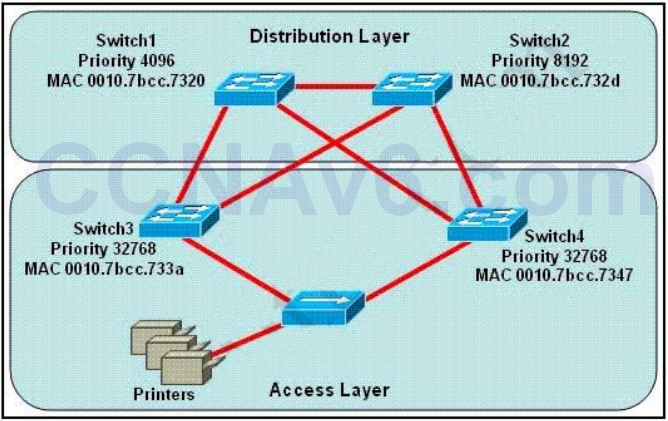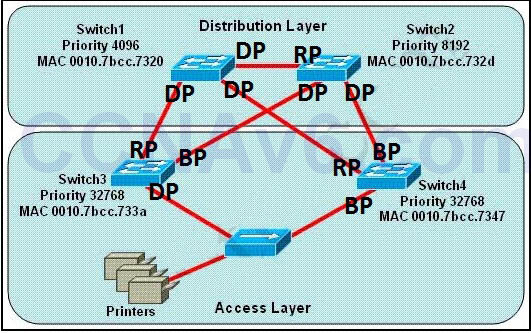- Which spanning-tree feature places a port immediately into a forwarding stated?
- A. BPDU guard
- B. PortFast*
- C. loop guard
- D. UDLD
- E. Uplink Fast
Show (Hide) Explanation/ReferenceWhen you enable PortFast on the switch, spanning tree places ports in the forwarding state immediately, instead of going through the listening, learning, and forwarding states. - Which switch would STP choose to become the root bridge in the selection process?
- A. 32768: 11-22-33-44-55-66 *
- B. 32768: 22-33-44-55-66-77
- C. 32769: 11-22-33-44-55-65
- D. 32769: 22-33-44-55-66-78
- Which type does a port become when it receives the best BPDU on a bridge?
- A. The designated port
- B. The backup port
- C. The alternate port
- D. The root port*
Show (Hide) Explanation/ReferenceRoot port is the port on non-root bridge which is closest to the root bridge (in term of cost). Therefore when a port receives the best BPDU on a non-root bridge it will become the root port. - Which value can you modify to configure a specific interface as the preferred forwarding interface?
- A. The interface number
- B. The port priority*
- C. The VLAN priority
- D. The hello time
Show (Hide) Explanation/ReferenceWe can configure the port priority to change the preferred forwarding interface as we wish. For example we can change the port priority of an interface for VLAN 20 to 64 as follows:Switch(config-if)#spanning-tree vlan 20 port-priority 64
- What is one benefit of PVST+?
- A. PVST+ reduces the CPU cycles for all the switches in the network.
- B. PVST+ automatically selects the root bridge location, to provide optimization.
- C. PVST+ allows the root switch location to be optimized per vlan.*
- D. PVST+ supports Layer 3 load balancing without loops.
Show (Hide) Explanation/ReferencePer VLAN Spanning Tree (PVST) maintains a spanning tree instance for each VLAN configured in the network. It means a switch can be the root bridge of a VLAN while another switch can be the root bridge of other VLANs in a common topology. For example, Switch 1 can be the root bridge for Voice data while Switch 2 can be the root bridge for Video data. If designed correctly, it can optimize the network traffic. - Three switches are connected to one another via trunk ports. Assuming the default switch configuration, which switch is elected as the root bridge for the spanning-tree instance of VLAN 1?
- A. the switch with the highest MAC address
- B. the switch with the lowest MAC address*
- C. the switch with the highest IP address
- D. the switch with the lowest IP address
- Which protocol is a Cisco proprietary implementation of STP?
- A. CST
- B. RSTP
- C. MSTP
- D. PVST+*
- A BPDU guard is configured on an interface that has PortFast enable. Which state does the interface enter when it receives a BPDU?
- A. Blocking
- B. Shutdown
- C. Listening
- D. Errdisable*
Show (Hide) Explanation/ReferencePortFast BPDU guard prevents loops by moving a nontrunking port into an errdisable state when a BPDU is received on that port.In a valid configuration, PortFast-configured interfaces do not receive BPDUs (because PortFast should only be configured on interfaces which are connected to hosts). If a PortFast-configured interface receives a BPDU, an invalid configuration exists. BPDU guard provides a secure response to invalid configurations because the administrator must manually put the interface back in service.
- Which two protocols are used by bridges and/or switches to prevent loops in a layer 2 network? (Choose two)
- A. 802.1D*
- B. VTP
- C. 802.1Q
- D. SAP
- E. STP*
- Refer to the exhibit. Which switch provides the spanning-tree designated port role for the network segment that services the printers?

- A. Switch1
- B. Switch2
- C. Switch3*
- D. Switch4
Show (Hide) Explanation/ReferenceFirst, the question asks what switch services the printers, so it can be Switch 3 or Switch 4 which is connected directly to the Printers.Next, by comparing the MAC address of Switch 3 and Switch 4 we found that the MAC of Switch 3 is smaller. Therefore the interface connected to the Printers of Switch 3 will become designated interface and the interface of Switch 4 will be blocked. The picture below shows the roles of all ports:

DP: Designated Port
RP: Root Port
BP: Blocked Port(Please notice that Switch 1 will become the root bridge because of its lowest priority, not Switch 3)
CCNA 200-125 Exam: STP Questions 2 With Answers
Subscribe
0 Comments
